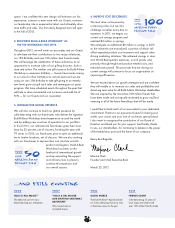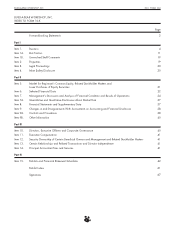Build-A-Bear Workshop 2011 Annual Report Download - page 18
Download and view the complete annual report
Please find page 18 of the 2011 Build-A-Bear Workshop annual report below. You can navigate through the pages in the report by either clicking on the pages listed below, or by using the keyword search tool below to find specific information within the annual report.
BUILD-A-BEAR WORKSHOP, INC. 2011 FORM 10-K
automatically collected from the stores’ point-of-sale terminals
and kiosks on a near real time basis.
We have developed award-winning, proprietary software
including our new Digital Sound Station, party scheduling
system and domestic and international versions of our Name
Me kiosk, which populates our Find-A-Bear®identification
system. Data from these systems are used to support key
decisions in all areas of our business, including
merchandising, allocation and operations. All data captured is
secured, Payment Card Industry compliant and protected by a
solid disaster recovery plan. Our critical systems are reviewed
on a regular basis to evaluate security and disaster recovery.
COMPETITION
We view the Build-A-Bear Workshop experience as a
distinctive combination of entertainment and retail with limited
direct competition. Because our signature product is a stuffed
animal, we compete with toy retailers, such as Wal-Mart, Toys
“R” Us, Target, Kmart and other discount chains. Build-A-Bear
Workshop was ranked by Playthings Magazine as the ninth
largest toy retailer for retailers with continuing operations,
based on 2008 revenues. Since we develop proprietary
products, we also compete indirectly with a number of
companies that sell stuffed animals in the United States,
including, but not limited to, Ty, Fisher Price, Mattel, Ganz,
Russ Berrie, Applause, Boyd’s, Hasbro, Commonwealth, Gund
and Vermont Teddy Bear. Since we sell a product that
integrates merchandise and experience, we also view our
competition as any company that competes for family time and
entertainment dollars, such as movie theaters, amusement
parks and arcades, other mall-based entertainment venues and
online entertainment. Being a mall-based retailer, we also
compete with other mall-based retailers for prime mall
locations, including various apparel, footwear and specialty
retailers.
We are aware of several small companies that operate
“make your own” teddy bear and stuffed animal stores or
kiosks in retail locations, but we believe none of those
companies offer the breadth and depth of the Build-A-Bear
Workshop experience or operate as a national or
international retail company.
We also believe that there is an emerging trend within
children’s play patterns towards mobile internet and online
play. According to Emarketer.com, kids aged 8 to 11
reported that they spend between one and two hours online
each day. We believe our bearville.com Web site competes
with other companies and internet sites that vie for children’s
attention in the online space including webkinz.com,
clubpenguin.com and neopets.com.
INTELLECTUAL PROPERTY AND TRADEMARKS
As of December 31, 2011, we had obtained over
232 U.S. trademark registrations, including Build-A-Bear
Workshop for stuffed animals and accessories for the animals,
retail store services and other goods and services, 36 issued
U.S. patents with expirations ranging from 2013 through
2020 and over 389 copyright registrations. In addition, we
have 12 U.S. trademark applications pending. We have
exclusive patent rights from two third parties in association
with our BUILD-A-SOUND message device and system. We
were granted exclusive licenses to use the device and system
covered by the patents in retail stores similar to ours. While
we have the right to sublicense the patent, the licensors have
agreed not to grant competing license rights to any of our
competitors. In the event that we or the licensors have reason
to believe that a third party is infringing upon the patents, the
licensors are generally required to bear the expenses required
to maintain and defend the patents. Our exclusive rights will
last until the expiration of the latest patent covered by each
agreement, calculated to be 2013 and 2017, respectively,
unless the agreements are terminated by either party.
We believe our copyrights, service marks, trademarks,
trade secrets, patents and similar intellectual property are
critical to our success, and we intend, directly or indirectly,
to maintain and protect these marks and, where applicable,
license the intellectual property and the registrations for the
intellectual property. We rely on trademark, copyright and
other intellectual property law to protect our proprietary rights
to the extent available in any relevant jurisdiction. We also
depend on trade secret protection through confidentiality and
license agreements with our employees, subsidiaries,
licensees, licensors and others. We may not have agreements
containing adequate protective provisions in every case, and
the contractual provisions that are in place may not provide us
with adequate protection in all circumstances. Any
infringement or misappropriation of our intellectual property
rights or breach of our confidentiality or license agreements
could result in significant litigation costs, and any failure to
adequately protect our proprietary rights could result in our
competitors offering similar products, potentially resulting in
loss of one or more competitive advantages and decreased
revenues. In addition, intellectual property litigation or claims
could force us to do one or more of the following: cease
selling or using any of our products that incorporate the
challenged intellectual property, which would adversely
affect our revenue; obtain a license from the holder of the
intellectual property right alleged to have been infringed,
which license may not be available on reasonable terms, if at
all; and redesign or, in the case of trademark claims, rename
our products to avoid infringing the intellectual property rights
of third parties, which may not be possible and time-
consuming if it is possible to do so.
Despite our efforts to protect our intellectual property
rights, intellectual property laws afford us only limited
protection. A third party could copy or otherwise obtain
information from us without authorization. Accordingly,
we may not be able to prevent misappropriation of our
intellectual property or to deter others from developing similar
products or services. Further, monitoring the unauthorized use
of our intellectual property is difficult. Litigation has been and
may continue to be necessary to enforce our intellectual
10
























